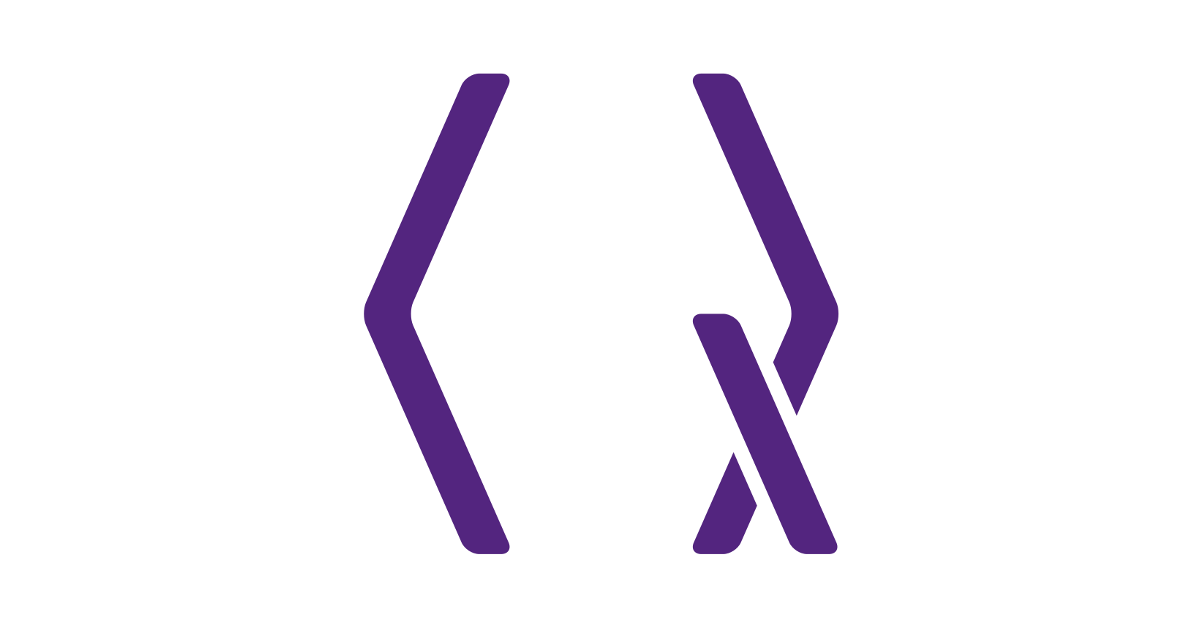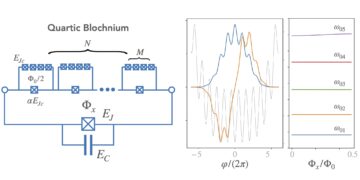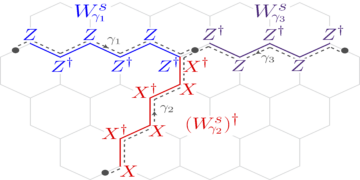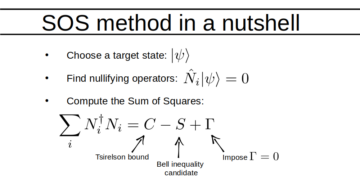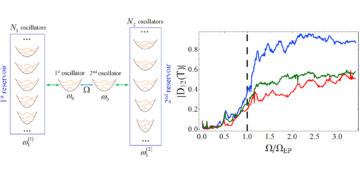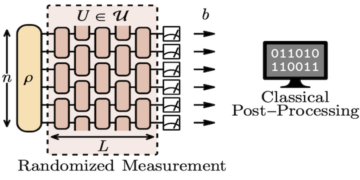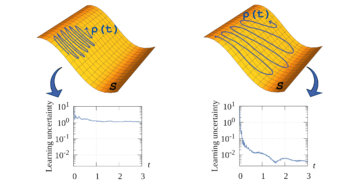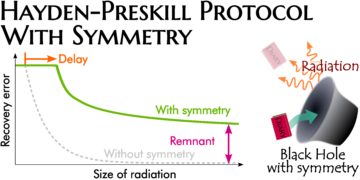1Hochschule für Physik und Optoelektronik, Universität Shenzhen, Shenzhen 518060, China
2Guangdong Provincial Key Laboratory of Quantum Metrology and Sensing & School of Physics and Astronomy, Sun Yat-Sen University (Zhuhai Campus), Zhuhai 519082, China
3Staatliches Schlüssellabor für optoelektronische Materialien und Technologien, Sun Yat-Sen-Universität (Guangzhou Campus), Guangzhou 510275, China
Findest du dieses Paper interessant oder möchtest du darüber diskutieren? Scite oder hinterlasse einen Kommentar zu SciRate.
Abstrakt
Die Invarianz unter Lorentz-Transformationen ist sowohl für das Standardmodell als auch für die allgemeine Relativitätstheorie von grundlegender Bedeutung. Das Testen der Verletzung der Lorentz-Symmetrie (LSV) über atomare Systeme zieht sowohl in der Theorie als auch im Experiment umfangreiches Interesse auf sich. In mehreren Testvorschlägen werden die LSV-Verletzungseffekte als lokale Wechselwirkung beschrieben und die entsprechende Testpräzision kann asymptotisch die Heisenberg-Grenze über zunehmende Quanten-Fisher-Informationen (QFI) erreichen, aber die begrenzte Auflösung kollektiver Observablen verhindert die Erkennung großer QFI. Hier schlagen wir eine Multimode-Vielteilchen-Quanteninterferometrie zum Testen des LSV-Parameters $kappa$ über ein Ensemble von Spinoratomen vor. Durch die Verwendung eines $N$-Atom-Multimode-GHZ-Zustands kann die Testpräzision die Heisenberg-Grenze $Delta kappa propto 1/(F^2N)$ mit der Spinlänge $F$ und der Atomzahl $N$ erreichen. Wir finden eine realistische Observable (dh praktisches Messverfahren), um die ultimative Präzision zu erreichen und analysieren den LSV-Test über eine experimentell zugängliche Drei-Moden-Interferometrie mit Bose-kondensierten Spin-$1$-Atomen zum Beispiel. Durch Auswahl geeigneter Eingangszustände und einheitlicher Rekombinationsoperation kann der LSV-Parameter $kappa$ über eine realisierbare Populationsmessung extrahiert werden. Insbesondere die Messgenauigkeit des LSV-Parameters $kappa$ kann die Standard-Quantengrenze übertreffen und sich sogar der Heisenberg-Grenze durch Spinmischungsdynamik oder Durchfahren von Quantenphasenübergängen annähern. Darüber hinaus ist das Schema robust gegenüber nicht-adiabatischen Effekten und Detektionsrauschen. Unser Testschema kann einen praktikablen Weg für eine drastische Verbesserung der LSV-Tests mit atomaren Systemen eröffnen und eine alternative Anwendung von Mehrteilchen-Verschränkungszuständen bieten.
Populäre Zusammenfassung
► BibTeX-Daten
► Referenzen
[1] CW Misner, KS Thorne und JA Wheeler, Gravitation (Freeman, San Francisco, 1970).
https:///doi.org/10.1002/asna.19752960110
[2] D. Mattingly, Living Rev. Relativity 8, 5 (2005).
https: / / doi.org/ 10.12942 / lrr-2005-5
[3] S. Liberati und L. Maccione, Annu. Rev. Nucl. Teil. Wissenschaft. 59, 245 (2009).
https:///doi.org/10.1146/annurev.nucl.010909.083640
[4] S. Liberati, Klasse. Quantengravitation 30, 133001 (2013).
https://doi.org/10.1088/0264-9381/30/13/133001
[5] JD Tasson, Rep.Prog. Phys. 77, 062901 (2014).
https://doi.org/10.1088/0034-4885/77/6/062901
[6] M. Pospelov, Y. Shang, Phys. Rev. D 85, 105001 (2012).
https://doi.org/ 10.1103/PhysRevD.85.105001
[7] VA Kostelecký und N. Russell, Rev. Mod. Phys. 83, 11 (2011).
https: / / doi.org/ 10.1103 / RevModPhys.83.11
[8] VA Kostelecký und R. Potting, Phys. Rev. D 51, 3923 (1995).
https://doi.org/ 10.1103/PhysRevD.51.3923
[9] D. Colladay und VA Kostelecký, Phys. Rev. D 55, 6760 (1997).
https://doi.org/ 10.1103/PhysRevD.55.6760
[10] D. Colladay und VA Kostelecký, Phys. Rev. D 58, 116002 (1998).
https://doi.org/ 10.1103/PhysRevD.58.116002
[11] VA Kostelecký, Phys. Rev. D 69, 105009 (2004).
https://doi.org/ 10.1103/PhysRevD.69.105009
[12] VA Kostelecký und JD Tasson, Phys. Rev. D 83, 016013 (2011).
https://doi.org/ 10.1103/PhysRevD.83.016013
[13] P. Hořava, Phys. Rev. D 79, 084008 (2009).
https://doi.org/ 10.1103/PhysRevD.79.084008
[14] VA Kostelecký und S. Samuel, Phys. Rev. D 39, 683 (1989).
https://doi.org/ 10.1103/PhysRevD.39.683
[15] R. Gambini und J. Pullin, Phys. Rev. D 59, 124021 (1999).
https://doi.org/ 10.1103/PhysRevD.59.124021
[16] SG Nibbelink, M. Pospelov, Phys. Rev. Lett. 94, 081601 (2005).
https://doi.org/ 10.1103/PhysRevLett.94.081601
[17] MR Douglas und NA Nekrasov, Rev. Mod. No. Phys. 73, 977 (2001).
https: / / doi.org/ 10.1103 / RevModPhys.73.977
[18] O. Bertolami, R. Lehnert, R. Potting und A. Ribeiro, Phys. Rev. D 69, 083513 (2004).
https://doi.org/ 10.1103/PhysRevD.69.083513
[19] RC Myers und M. Pospelov, Phys. Rev. Lett. 90, 211601 (2003).
https://doi.org/ 10.1103/PhysRevLett.90.211601
[20] MS Safronova, D. Budker, D. DeMille, DFJ Kimball, A. Derevianko und CW Clark, Rev. Mod. No. Phys. 90, 025008 (2018).
https: / / doi.org/ 10.1103 / RevModPhys.90.025008
[21] MA Hohensee, N. Leefer, D. Budker, C. Harabati, VA Dzuba und VV Flambaum, Phys. Rev. Lett. 111, 050401 (2013).
https://doi.org/ 10.1103/PhysRevLett.111.050401
[22] T. Pruttivarasin, M. Ramm, SG Porsev, I. Tupitsyn, MS Safronova, MA Hohensee und H. Häffner, Nature (London) 517, 592 (2015).
https: / / doi.org/ 10.1038 / nature14091
[23] VA Dzuba, VV Flambaum, MS Safronova, SG Porsev, T. Pruttivarasin, MA Hohensee und H. Häffner, Nat. Phys. 12, 465 (2016).
https: / / doi.org/ 10.1038 / nphys3610
[24] R. Shaniv, R. Ozeri, MS Safronova, SG Porsev, VA Dzuba, VV Flambaum und H. Häffner, Phys. Rev. Lett. 120, 103202 (2018).
https://doi.org/ 10.1103/PhysRevLett.120.103202
[25] VA Kostelecký, C. Lane, Phys. Rev. D 60, 116010 (1999).
https://doi.org/ 10.1103/PhysRevD.60.116010
[26] L. Li, X. Li, B. Zhang und L. You, Phys. Rev. A 99, 042118 (2019).
https: / / doi.org/ 10.1103 / PhysRevA.99.042118
[27] VA Kostelecký und CD Lane, J.Math. Phys. (NY) 40, 6245 (1999).
https: / / doi.org/ 10.1063 / 1.533090
[28] JJ Bollinger, WM Itano und DJ Wineland, Phys. Rev. A 54, R4649 (1996).
https: / / doi.org/ 10.1103 / PhysRevA.54.R4649
[29] T. Monz, P. Schindler, JT Barreiro, M. Chwalla, D. Nigg, WA Coish, M. Harlander, W. Hänsel, M. Hennrich und R. Blat, Phys. Rev. Lett. 106, 130506 (2011).
https://doi.org/ 10.1103/PhysRevLett.106.130506
[30] J. Huang, X. Qin, H. Zhong, Y. Ke und C. Lee, Sci. Rep. 5, 17894 (2015).
https: / / doi.org/ 10.1038 / srep17894
[31] C. Lee, Phys. Rev. Lett. 97, 150402 (2006).
https://doi.org/ 10.1103/PhysRevLett.97.150402
[32] C. Lee, Phys. Rev. Lett. 102, 070401 (2009).
https://doi.org/ 10.1103/PhysRevLett.102.070401
[33] SD Huver, CF Wildfeuer und JP Dowling, Phys. Rev. A 78, 063828 (2008).
https: / / doi.org/ 10.1103 / PhysRevA.78.063828
[34] C. Lee, J. Huang, H. Deng, H. Dai und J. Xu, Front. Phys. 7, 109 (2012).
https://doi.org/10.1007/s11467-011-0228-6
[35] Y. Kawaguchia, M. Ueda, Phys. Rep. 520, 253 (2012).
https://doi.org/ 10.1016/j.physrep.2012.07.005
[36] M. Zhuang, J. Huang und C. Lee, Phys. Rev. A. 98, 033603 (2018).
https: / / doi.org/ 10.1103 / PhysRevA.98.033603
[37] SC Burd, R. Srinivas, JJ Bollinger, AC Wilson, DJ Wineland, D. Leibfried, DH Slichter, DTC Allcock, Science 364, 1163 (2019).
https: / / doi.org/ 10.1126 / science.aaw2884
[38] D. Linnemann, H. Strobel, W. Muessel, J. Schulz, RJ Lewis-Swan, KV Kheruntsyan und MK Oberthaler, Phys. Rev. Lett. 117, 013001 (2016).
https://doi.org/ 10.1103/PhysRevLett.117.013001
[39] O. Hosten, R. Krishnakumar, NJ Engelsen, MA Kasevich, Science 352, 6293 (2016).
https: / / doi.org/ 10.1126 / science.aaf3397
[40] SS Mirkhalaf, SP Nolan und SA Haine, Phys. Rev. A 97, 053618 (2018).
https: / / doi.org/ 10.1103 / PhysRevA.97.053618
[41] F. Fröwis, P. Sekatski und W. Dür, Phys. Rev. Lett. 116, 090801 (2016).
https://doi.org/ 10.1103/PhysRevLett.116.090801
[42] SS Szigeti, RJ Lewis-Swan und SA Haine, Phys. Rev. Lett. 118, 150401 (2017).
https://doi.org/ 10.1103/PhysRevLett.118.150401
[43] J. Huang, M. Zhuang, B. Lu, Y. Ke und C. Lee, Phys. Rev. A 98, 012129 (2018).
https: / / doi.org/ 10.1103 / PhysRevA.98.012129
[44] J. Huang, M. Zhuang und C. Lee, Phys. Rev. A 97, 032116 (2018).
https: / / doi.org/ 10.1103 / PhysRevA.97.032116
[45] F. Anders, L. Pezzè, A. Smerzi und C. Klempt, Phys. Rev. A 97, 043813 (2018).
https: / / doi.org/ 10.1103 / PhysRevA.97.043813
[46] T. Jacobson, arXiv:0801.1547 (2007).
https: / / doi.org/ 10.1142 / 9789812779519_0014
arXiv: 0801.1547
[47] D. Blas, O. Pujolas und S. Sibiryakov, Phys. Rev. Lett 104, 181302 (2010).
https://doi.org/ 10.1103/PhysRevLett.104.181302
[48] AA Ungar, Symmetrie 12, 1259 (2020).
https:///doi.org/10.3390/sym12081259
[49] TP Heavner, SR Jefferts, EA Donley, JH Shirley und TE Parker, Metrologia 42, 411 (2005).
https://doi.org/10.1088/0026-1394/42/5/012
[50] S. Weyers, V. Gerginov, N. Nemitz, R. Li und K. Gibble, Metrologia 49, 82 (2012).
https://doi.org/10.1088/0026-1394/49/1/012
[51] B. Wu, ZY Wang, B. Cheng, QY Wang, AP Xu und Q. Lin, J. Phys. Schläger. Mol. Option. Phys. 47, 015001 (2014).
https://doi.org/10.1088/0953-4075/47/1/015001
[52] EB Alexandrow, Phys. Scr., 2003, 27 (2003).
https:///doi.org/10.1238/Physica.Topical.105a00027
[53] SJ Seltzer, PJ Meares und MV Romalis, Phys. Rev. A 75, 051407(R) (2007).
https: / / doi.org/ 10.1103 / PhysRevA.75.051407
[54] K. Jensen, VM Acosta, JM Higbie, MP Ledbetter, SM Rochester und D. Budker, Phys. Rev. A 79, 023406 (2009).
https: / / doi.org/ 10.1103 / PhysRevA.79.023406
[55] G. Tóth und I. Apellaniz, J. Phys. A: Mathe. Theor. 47, 424006 (2014).
https://doi.org/10.1088/1751-8113/47/42/424006
[56] R. Demkowicz-Dobrzański, M. Jarzyna und J. Kolodyński, Progress in Optics, herausgegeben von E. Wolf (Elsevier, Bd. 60, 2015).
https: / / doi.org/ 10.1016 / bs.po.2015.02.003
[57] L. Pezzé und A. Smerzi, Phys. Rev. Lett. 102, 100401 (2009).
https://doi.org/ 10.1103/PhysRevLett.102.100401
[58] P. Hyllus, L. Pezzé und A. Smerzi, Phys. Rev. Lett. 105, 120501 (2010).
https://doi.org/ 10.1103/PhysRevLett.105.120501
[59] J. Huang, S. Wu, H. Zhong und C. Lee, Annu. Rev. Kalt bei. Mol. 2, 365 (2014).
https: / / doi.org/ 10.1142 / 9789814590174_0007
[60] SL Braunstein und CM Caves, Phys. Rev. Lett. 72, 3439 (1994).
https://doi.org/ 10.1103/PhysRevLett.72.3439
[61] V. Giovannetti, S. Lloyd und L. Maccone, Science 306, 1330 (2004).
https: / / doi.org/ 10.1126 / science.1104149
[62] V. Giovannetti, S. Lloyd und L. Maccone, Nature Photon 5, 222 (2011).
https: / / doi.org/ 10.1038 / nphoton.2011.35
[63] JG Bohnet, BC Sawyer, JW Britton, MLWall, AM Rey, M. Foss-Feig und JJ Bollinger, Science 352, 1297 (2016).
https: / / doi.org/ 10.1126 / science.aad9958
[64] Z. Zhang und L.-M. Duan, Phys. Rev. Lett. 111, 180401 (2013).
https://doi.org/ 10.1103/PhysRevLett.111.180401
[65] Y. Zou, L. Wu, Q. Liu, X. Luo, S. Guo, J. Cao, M. Tey und L. You, Proc Natl Acad Sci USA 201, 7151 (2018).
https: / / doi.org/ 10.1073 / pnas.1715105115
[66] X. Luo, Y. Zou, L. Wu, Q. Liu, M. Han, M. Tey und L. You, Science 355, 620 (2017).
https: / / doi.org/ 10.1126 / science.aag1106
[67] S. Guo, F. Chen, Q. Liu, M. Xue, J. Chen, J. Cao, T. Mao, MK Tey und L. You, Phys. Rev. Lett. 126, 060401 (2021).
https://doi.org/ 10.1103/PhysRevLett.126.060401
[68] DM Stamper-Kurn und M. Ueda, Rev. Mod. No. Phys. 85, 1191 (2013).
https: / / doi.org/ 10.1103 / RevModPhys.85.1191
[69] M. Gabbrielli, L. Pezzè und A. Smerzi, Phys. Rev. Lett. 115, 163002 (2015).
https://doi.org/ 10.1103/PhysRevLett.115.163002
[70] T. Ho, Phys. Rev. Lett. 81, 742 (1998).
https://doi.org/ 10.1103/PhysRevLett.81.742
[71] T. Ohmi und K. Machida, J. Phys. Soc. Jpn. 67, 1822 (1998).
https: / / doi.org/ 10.1143 / JPSJ.67.1822
[72] E. Davis, G. Bentsen und M. Schleier-Smith, Phys. Rev. Lett. 116, 053601 (2016).
https://doi.org/ 10.1103/PhysRevLett.116.053601
[73] T. Macrì, A. Smerzi und L. Pezzè, Phys. Rev. A 94, 010102 (2016).
https: / / doi.org/ 10.1103 / PhysRevA.94.010102
[74] SP Nolan, SS Szigeti und SA Haine, Phys. Rev. Lett. 119, 193601 (2017).
https://doi.org/ 10.1103/PhysRevLett.119.193601
[75] L. Pezzé und A. Smerzi, Phys. Rev. Lett. 110, 163604 (2013).
https://doi.org/ 10.1103/PhysRevLett.110.163604
[76] M. Zhuang, J. Huang und C. Lee, Phys. Rev. Angewendet 16, 064056 (2021).
https: / / doi.org/ 10.1103 / PhysRevApplied.16.064056
[77] H. Xing, A. Wang, QS Tan, W. Zhang und S. Yi, Phys. Rev. A 93, 043615 (2016).
https: / / doi.org/ 10.1103 / PhysRevA.93.043615
Zitiert von
Konnte nicht abrufen Crossref zitiert von Daten während des letzten Versuchs 2022-11-14 13:13:07: Von Crossref konnten keine zitierten Daten für 10.22331 / q-2022-11-14-859 abgerufen werden. Dies ist normal, wenn der DOI kürzlich registriert wurde. Auf SAO / NASA ADS Es wurden keine Daten zum Zitieren von Werken gefunden (letzter Versuch 2022-11-14 13:13:08).
Dieses Papier ist in Quantum unter dem veröffentlicht Creative Commons Namensnennung 4.0 International (CC BY 4.0) Lizenz. Das Copyright verbleibt bei den ursprünglichen Copyright-Inhabern wie den Autoren oder deren Institutionen.

